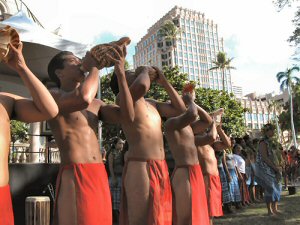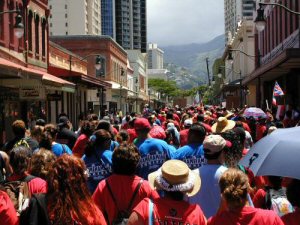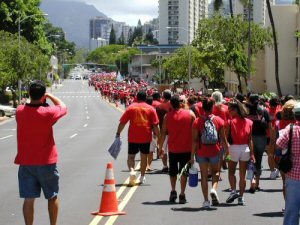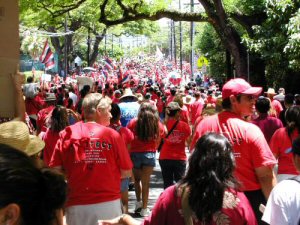It seems to me that sometimes, we resist change even when, in the long run, it will benefit us. Perhaps because it is seen as work to implement a change. Maybe because, in the short-term, the change is not advantageous or because we didn't initiate the change and we don't trust others who want to force change upon us. Sometimes we resist change because our eyes are clouded and therefore cannot see the good end result. Other times, we may may understand the need for change, but stay silent out of respect for others who may not understand and therefore be offended by such a change.
This may be one of those times in which all of the above is occurring. However, I cannot remain silent because the stakes are much too high and the damage that could result is too great to stand by and watch a great institution be torn apart.
Before I go farther [insert the standard disclaimer here], I need to note, as I've noted before, that I attended the Kamehameha Schools (but did not graduate from there), a private school founded in 1887 through the will of the last surviving royal descendant of King Kamehameha -- Princess Bernice Pauahi Bishop.
At the time I was there, in the early 1970's, the Kamehameha Schools had only one campus and approximately 3,000 students (kindergarten through 12th grade) encompassing all races, backgrounds, and religions (but with a preference for native Hawaiians).
With that said, a brief history may be helpful to further set the context of the situation.
Before the arrival of foreign peoples, as many as 800,000 native Hawaiians may have lived on these blessed islands (pre-contact population estimates vary from a low of 200,000 to over 800,000. Compare this to the present day total population of not just Hawaiians, of about 1.2 million).
But due to our isolated location, Hawaiians, for centuries, had no contact with other peoples and therefore had built up no resistance to even what many consider to be common childhood diseases. But after coming in contact with such disease carrying foreign peoples in the late 1700s, the population declined, in the span of just over one generation, to less than 50,000.
Reacting in horror to the shocking and rapidly continuing decline in the population of her people, the Princess hastened to try, if possible, to provide for their educational needs after the last of the Kamehameha line was gone. One must remember that, due to this rapid decline, it wasn't at all clear there would be any native Hawaiians to educate after her death. Hence her will did not say to educate only native Hawaiians, fearing there wouldn't be any, rather only that preference should be given to native Hawaiians, if any, and especially those who were orphaned. But her other writings, and those of whom she spoke to, seem to clearly indicate she was desperately trying to spare as many native Hawaiians as she could, through education, so that they would not disappear from the face of the Earth.
For the more than two centuries since then, the Kamehameha Schools/Bishop Estate (hereinafter Estate), the entity created to fund the school, was cash poor but land rich. Indeed, at the time of her death, Princess Pauahi owned approximately one-tenth of all lands in the Hawaiian islands.
However, because much of these lands were in remote areas not immediately fit for habitation or set aside for watershed or other conservation efforts revenues from said lands were relatively small and therefore the school did not have the resources to expand.
But some of the Estate's lands included prime properties in Waikiki and the very expensive area called Kahala. However, it is my understanding that the Estate leased these lands at, for the most part, below market value. Why this was done is a long and winding road down paths littered with greed, politics, intrigue, double dealing, and Estate trustees seemingly more concerned with lining their pockets than educating children of Hawaiian ancestry.
That said, one of the lessons learned by native Hawaiians was that land was the basis for all that exists. Without land, you are nothing. Hence, we were loathe to part with any land, even if it might be beneficial to do so in certain instances.
When the Estate eventually began to raise lease rents to market values, politically adept lessees became angry and persuaded the local city council to pass an ordinance requiring the Estate to sell certain lands in fee (the lessees had to meet various requirements but having done so, the Estate had to sell regardless of what the Estate wanted to do).
Various native Hawaiian groups were up in arms and cried over how their land was being stolen. Although it can be argued that they were right, the forced selling of the land was found legal.
If there was a silver lining to this dark cloud, the eventual outcome of all these former lessees buying the Estate land in fee is that the Estate now has an estimated worth of about $6.2 billion USD and is one of the larger charitable trusts in the US, if not perhaps the world.
With these new funds, the school has expanded to two other islands (Maui and Hawaii) and now enrolls, through the various campuses and pre-school programs approximately 6,500 students; making Kamehameha the largest, independent private school in the entire United States.
But last week, three federal judges, in the much larger US Court of Appeals for the Ninth Circuit ruled (warning: link goes to a PDF) that the Kamehameha Schools policy on giving preference to Hawaiians is illegal under federal statute 42 U.S.C. § 1981.
Although this case still has a ways to go before it is finally settled, I have long felt that native Hawaiians will not find justice in the US legal system. The US system simply does not sufficiently take into account the special needs of this place and its people and perhaps, never will.
In the final analysis, I have come to believe that it is only through self-governance that we can find justice. Whether we will ever become self-governing I cannot say. But in the mean time, I think we have to prepare for the harm that certain groups of people will try to do to us in the name of the law.
In chess, you sometimes sacrifice a pawn now to create the opportunity for a better position in later moves. Likewise, I believe the admission criteria for the Kamehameha Schools should be amended to provide for the education of all Hawaii's children, native Hawaiian and not. By doing so, the school itself can continue on.
I believe this for two reasons. First, it may avoid a long and costly legal battle that, in the end, we may lose. Millions will be spent defending us against laws that were originally created to end white racist control over Blacks. These laws are now effectively being turned against native Hawaiians, by some of the same types of people that so long ruled over Blacks.
Our programs, such as the Office of Hawaiian Affairs, was first to be successfully attacked by certain haoles. Now, it is the Kamehameha Schools. Who knows what will be next. But in the end, I believe, it is just a matter when, not if, most if not all the programs created to help right the wrongs perpetuated against native Hawaiians will be found illegal.
Secondly, native Hawaiians are no longer in danger of becoming extinct. If anything, the number of Hawaiians or part-Hawaiians is growing [Late update, the Census Bureau released data which shows a decline in native Hawaiian population over the last four years. Read the full story here]. If things continue as they are, there is no danger whatsoever that we will go the way of the Dodo bird. I believe the mission of the Kamehameha Schools should reflect the changed circumstances and remove the policy of only native Hawaiians and expand it to all children in Hawaii (realizing, of course, that no private school has the funding to enroll all students).
I believe we must adapt. I believe the future is ahead of us, not behind. I believe that if we meet the challenges before us, we will come out of this a stronger people for it just as the Estate has become financially stronger as a result of converting lease to fee.
In the end, I agree with the Princess that the way to save ourselves is through education. And by educating everyone, we can now only grow stronger until that day when we can govern ourselves and sing, in the words of the old Black spiritual: "Free at last! Free at last! Thank God Almighty, we are free at last!"
Although I did not attend the march, below are some photos taken during the march held last Saturday. It is estimated between 10,000 to 15,000 participated in the march from I'olani Palace to Mauna Ala (the final resting place of the royal ali'i). Photos found on the Internet from various sources.

The powerful and resonant sound emanating
from the massed conch shells gave me
"chicken skin" when I heard them on the news.

Heading mauka through Chinatown.

Half-way there.

Almost there.
For additional reading:
The Washington Post
Aloha!
